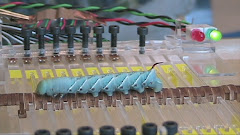While we are waiting for the caterpillar robot video links, let's come back to some morphological discussion of lepidoptera larvae. All my biomechanics studies so far are based on a well-known model system tobacco hornworm (
Manduca sexta). It is a fair size macro-lepidopera species commonly found in the America. It has 4 pairs of abdominal prolegs plus 1 pair of anal prolegs (or terminal prolegs). This is thought to be the ancestral form.

However, we are perfectly aware of the diversity of lepidoptera species. Caterpillars really vary in numbers and arrangement of prolegs. They also adopt different gait patterns accordingly. So how do we generalize what we learned from
Manduca? Or can we?

To find out why, I am planning a field study to compare body overall scaling across different species of caterpillar. Although much work has been done on comparing morphological changes in the evolutionary context of species interaction, little is known about the physical constraints during evolution. I believe that there is a link between locomotor biomechanics and the evolution of prolegs configuration.
 However, we are perfectly aware of the diversity of lepidoptera species. Caterpillars really vary in numbers and arrangement of prolegs. They also adopt different gait patterns accordingly. So how do we generalize what we learned from Manduca? Or can we?
However, we are perfectly aware of the diversity of lepidoptera species. Caterpillars really vary in numbers and arrangement of prolegs. They also adopt different gait patterns accordingly. So how do we generalize what we learned from Manduca? Or can we? To find out why, I am planning a field study to compare body overall scaling across different species of caterpillar. Although much work has been done on comparing morphological changes in the evolutionary context of species interaction, little is known about the physical constraints during evolution. I believe that there is a link between locomotor biomechanics and the evolution of prolegs configuration.
To find out why, I am planning a field study to compare body overall scaling across different species of caterpillar. Although much work has been done on comparing morphological changes in the evolutionary context of species interaction, little is known about the physical constraints during evolution. I believe that there is a link between locomotor biomechanics and the evolution of prolegs configuration.

.jpg)
Hey Huai-Ti Lin
ReplyDeleteInteresting page you got here. I am doing my PhD on the evoluton of the lepidopteran abdominal prolegs. I think you are right about the link between the biomechanics and evolution of prolegs.
I mean the most basal Leps. had no prolegs but are nearly all leaf miners and have very different locomotion as they can utilize two opposing surfaces to move in between. The first prolegs observed on the Hepialidae are probably linked with the earthen silk galleries where the proleg crotchets were used to walk on silken tapestries..
you are doing some cool work hope to have time to keep an eye on you development.
Best regards Steen Dupont
Thanks for the comment Steen! I'm so glad to hear some resonance from the community of evolutionary biology. Actually, I have not looked into how prolegs interact with silken tapestries. I will pay attention to that this May when I do field work in Costa Rica.
ReplyDeletePlease do stay in touch with me via my blog or my e-mail. Cheers!
Well It appears that the only Lep. that still uses its crothchets for silk walking are the Hepialids (Hepialidae), that are soil dwellers and make silk galleries that they live in... the interesting thing is that the extension and release of the proleg crotchets is well designed to hook onto and release silk..
ReplyDeleteTry to read Hasenfuss and Kristensen (2003) in volume 2 of the zoological handbook (Hinton (1955) I think and Birket-Smith (1984) . By the way do you know anything about the characteristics of caterpillar integument.. well you do cause I have one of your articles about it (" Soft-cuticle biomechanics: A constitutive model of anisotropy for caterpillar integument"), but i was also thinking about the integument properties such as wetability or friction..
I will stay in touch.. trying to get my own blog up..